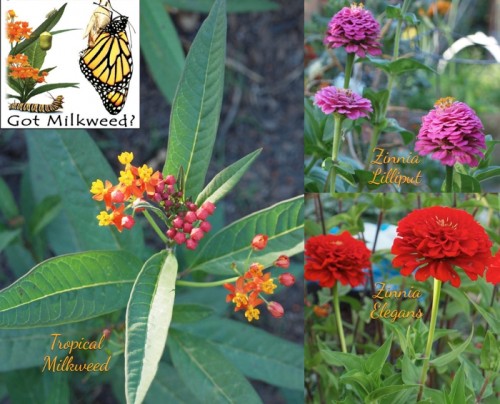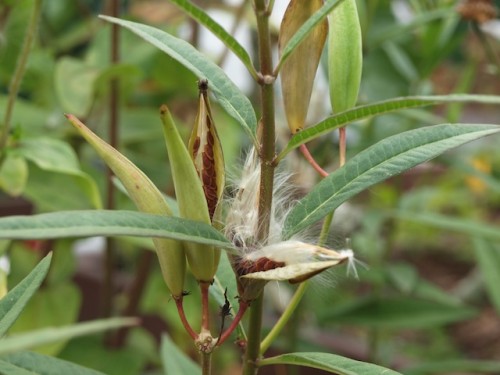 Help save the Monarch butterflies and draw other local beauties to your garden. I have a limited supply of Tropical Milkweed seeds grown in our Grant St. garden. Asclepias-curassavica aka Tropical or Mexican Milkweed – This is hands down the favorite egg laying and food plant of Monarchs. Fast growing produces as much as 1,000 seeds per plant to save and share. Used as a backup resource when local varieties are exhausted. There is controversy about growing Tropical Milkweed, (which is now considered a native Milkweed for California). Most of the controversy can be answered – more information here and here
Help save the Monarch butterflies and draw other local beauties to your garden. I have a limited supply of Tropical Milkweed seeds grown in our Grant St. garden. Asclepias-curassavica aka Tropical or Mexican Milkweed – This is hands down the favorite egg laying and food plant of Monarchs. Fast growing produces as much as 1,000 seeds per plant to save and share. Used as a backup resource when local varieties are exhausted. There is controversy about growing Tropical Milkweed, (which is now considered a native Milkweed for California). Most of the controversy can be answered – more information here and here
Also available are Zinnia Elegans seeds which are nectar plants to draw Monarchs and other butterflies. Milkweed has orange flowers, red or yellow flowers, zinnias are pink, red and orange tones.
Other Seed Resources
Native species in addition to Tropical Milkweed include Showy Milkweed and Narrow Leaf Milkweed. http://monarchbutterflygarden.net/milkweed-plant-seed-resources/
Raising Monarchs
The very best resource for raising information is from Monarch Butterfly Garden – http://monarchbutterflygarden.net Site owner Tony Gomez has been raising Monarchs for 30 years, and has a splendid ebook “Bring Home the Butterflies” http://monarchbutterflygarden.net/raising-monarch-butterflies-ebook/ I got my seeds from this site – http://www.glorious-butterfly.com/butterfly-garden.html This site also has instructions for raising Monarchs in the house or in a butterfly cage – http://www.glorious-butterfly.com/life-cycle-of-the-monarch-butterfly.html Another fantastic site to get seeds and when in stock butterfly nectar and host plants is www.joyfulbutterfly.com This beautifully designed website has plenty of butterfly info, articles, videos and images.
Wonderful YouTube video on the Monarch life cycle :
Growing Milkweed
Milkweeds can be propagated from seeds, cuttings, and, in some cases, from root divisions. Milkweed seeds can be planted in prepared beds outdoors or started indoors in flats. Germination rates are generally higher indoors and it is easier to establish your milkweeds with transplanted seedlings that are well-rooted and therefore more resistant to weather extremes and pests. G rowing Milkweeds from Cuttings All milkweeds are perennials and some can be grown from cuttings. Cuttings provide a way producing new plants in a relatively short time and it avoids some of the difficulties of starting plants from seeds. To start cuttings, cut the stems underwater, then coat the bottom of the stem with a strong rooting hormone. The stems should be placed in sand, vermiculite, or potting soil that is kept continuously moist. Cuttings can usually be transplanted in 6-10 weeks. Survival is best when cuttings are made from green stems (1/3 inch diameter) obtained from plants fertilized two weeks earlier. Soil Types If you have a choice, light soils are better than those with heavy clay. Well-drained soils are generally best but there are some species, e.g. A. incarnata (swamp milkweed) and A. sullivantii, which do well in saturated conditions. Where to Plant Most milkweed species evolved in open areas where they were exposed to full sunlight and they will do best if they are planted in the sunniest areas of your gardens. A few species, such as A. purpurascens, appear to require partial shade.
rowing Milkweeds from Cuttings All milkweeds are perennials and some can be grown from cuttings. Cuttings provide a way producing new plants in a relatively short time and it avoids some of the difficulties of starting plants from seeds. To start cuttings, cut the stems underwater, then coat the bottom of the stem with a strong rooting hormone. The stems should be placed in sand, vermiculite, or potting soil that is kept continuously moist. Cuttings can usually be transplanted in 6-10 weeks. Survival is best when cuttings are made from green stems (1/3 inch diameter) obtained from plants fertilized two weeks earlier. Soil Types If you have a choice, light soils are better than those with heavy clay. Well-drained soils are generally best but there are some species, e.g. A. incarnata (swamp milkweed) and A. sullivantii, which do well in saturated conditions. Where to Plant Most milkweed species evolved in open areas where they were exposed to full sunlight and they will do best if they are planted in the sunniest areas of your gardens. A few species, such as A. purpurascens, appear to require partial shade.